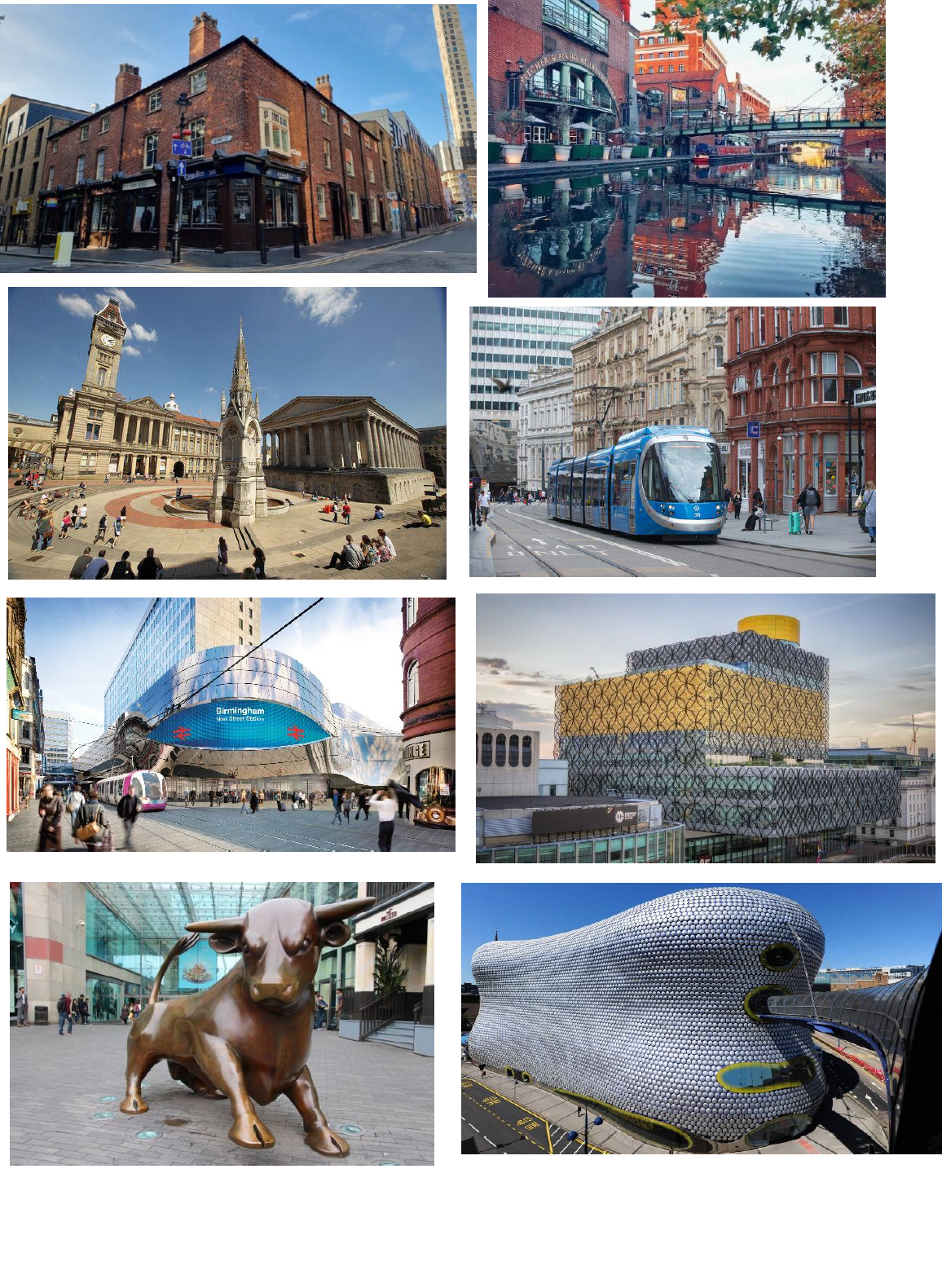 |
(2023.02.21) |
日本語と英語版があります。 This post is available in both Japanese and English, please scroll down for the English version.
...
私はバーミンガム出身なので、バーミンガム市の観光地と魅力的な場所について話したいと思います。9歳から昨年岐阜市に来るまでバーミンガム市に住んでいました。お母さんと友達の多くもバーミンガム市にまだ住んでいます。実は、イギリスではバーミンガムのイメージが悪いです。醜い、貧しいと思っている人が多いです。私の意見ですが、この考え方は正しくありません!バーミンガム市にはたくさんの綺麗な場所、歴史的なことや美術館が見られます。
まずバーミンガム市を紹介します。バーミンガムはイギリスのウェスト・ミッドランズにある都市です。ウェスト・ミッドランズの意味は「中西部」の感じです。バーミンガム市と岐阜市はともに国の「中部」にあります。ロンドンについで、バーミンガムはイングランドの第2の都市といわれています。2021年にバーミンガムの人口はイギリス第2位で114万人でしたが、ロンドンの人口は945万人でした。
中部なので、交通機関が便利です。例えば、イギリスに新幹線はありませんが、日本より広くないので、バーミンガムからロンドンまで、電車で1時間半ぐらいで行くことができます。大学時代に、私は北の方のリーズ市に住んでいましたが、バーミンガムまで電車で2時間ぐらいです。西に行くと、簡単にウェールズに行けます。バーミンガム市内の交通機関も繋がっています。現代のイギリスの問題は、「ロンドン以外での交通機関の整備が足りない」ことですが、バーミンガム市は電車、路面電車、バスといった交通機関が整っています。
次に、バーミンガムは歴史的にそれほど古い町ではありません。産業革命に建てられました。産業革命以前は、バーミンガム市はたくさんの小さい村でした。その村が集まり、バーミンガム市になりました。現代のバーミンガムにはまだ産業革命時代の歴史的な建物が見られます。一番有名なものはバーミンガム都心にあるバック・トゥ・バック住宅です。「バック・トゥ・バック住宅」とは一室の住居を背中あわせに並べた背割り長屋で、仕切り壁で4つの壁の内3つを共有し正面の壁にはドアと窓しかありません。英語で「バック・back」の意味は「後ろ」です。それで、そんな住宅の名前が付けられました。イギリス中で見られるテラスハウスと似ていますが、違いはテラスハウスは二つの壁が隣の家と共有しているということです。多くのテラスハウスはこの時代に建てられましたが、今もまだ住まれています。一方で、バック・トゥ・バック住宅は取り壊されました。産業革命の間、工場がある街の人口が激増したので、住宅不足が問題でした。バック・トゥ・バック住宅は安く、住宅不足を解消するために、多くのバック・トゥ・バック住宅が建てられました。それらは労働者の住宅になりましたが、建造物は低水準なので、健康と衛生上の質が悪くなりました。労働者の家族は貧しかったので、一つの家族は一つの部屋に住んでいました。結果バック・トゥ・バック住宅が過密で、汚くなり、スラムのようになりました。19世紀末に新しいバック・トゥ・バック住宅を建てることは違反になりました。バーミンガム市に観光地の博物館としてバック・トゥ・バック住宅が見られます。誰もここには住んでいません!ツアーを通して、ここに住んだ人の生活について学べます。
イギリスの多くの産業革命の街には運河が見られます。バーミンガムでは綺麗な運河沿いを散歩できます。都心にも、運河が多いです。その周辺にはレストラン、バー、ホールも多いです。シンフォニーホールという演奏会場、モダンな美術館、劇場といった観光地もあります。バーミンガムには19世紀と20世紀の歴史的な建物が多いです。例えば、バーミンガム市美術館は1885年に建てられました。コーポレーション・ストリートという有名な商店街では、赤いレンガ作られたビルも多いです。しかし、都市に歴史的なビルのみならず、モダンなビルも建設されていて、新旧の建築が混在しています!自治体はバーミンガム市の評判を変えるために、再開発に取り組んでいます。1970、1980年代のブルータリズムは「醜い」と思われていて、全然人気がないので、多くのビルを壊し、新しいモダン建築に建て換えています。イギリスの19世紀の建築は美しく、例えば、バーミンガム公共図書館は2013年に建て直されました。外観からすごいモダンスタイルで、展望台からバーミンガム中心が見られます。イギリスでロンドンにある駅以外に、一番混んでいるのはバーミンガム・ニューストリート駅です。小さすぎたので、2010年から2015年までリニューアルされました。拡大ばかりか、駅にあるモールも立て直しました。モールの名前はニューヨークの駅と同じように、グランドセントラルになりました。外の建築はモザイクみたいに鏡だらけです。
バーミンガム市美術館と言えば、常設展示の中で、一番有名なものはラファエル前派です。ラファエル前派は19世紀のイギリス人美術家のグループです。14、15世紀のイタリア人の美術家をきっかけに、中世とキリスト教に基づいている絵を描きました。また、ウェスト・ミッドランズのスタッフォードシャー州の出土品も見られます。この周辺で、7世紀から4000以上のアングロサクソン金と銀で作られたものが見つけられました。多くは兜、刀といった戦争のためのものでした。バーミンガム市の歴史だけではなく、美術や出土品についても学べます。
博物館、美術館、建築を見ることばかりでなく、バーミンガム市の都心で買い物することがイギリスで有名で、周りの町から土日に多くの人がバーミンガムに来ます。ブルリングやセルフリッジは一番人気なモールです。ともに2003年に建設されました。ブルリングの「ブル・bull」の意味は雄の牛なので、モールの外にブルの像があります。季節によって、ブルは飾られます。例えば、クリスマスにブルはサンタクロースの帽子を被ります。セルフリッジは、湾曲した外壁にアルミニウムの円盤が取り付けられています。この二つと前話したグランドセントラルは繋がっていますので、イギリスの都心にある一番大きいモールです。
バーミンガムの記事は2部に分けたので、他の魅力については次の記事をご覧ください!

All about Birmingham, England's second city (part 1)
...
As Birmingham is my hometown, this article will cover tourist sites and other noteworthy and pretty parts of the city. I moved to Birmingham when I was 9 years old, and lived there until I moved to Gifu, and my mum and many of my friends still live in Birmingham. Interestingly, in the UK the stereotypes about Birmingham are mostly negative! The city is thought of as ugly and impoverished! Of course, all cities have more affluent areas and poorer areas, as well as their good and bad points, however I think this widespread view of Birmingham is inaccurate! Birmingham has beautiful places, historical sites and great art galleries, which I will provide an introduction to throughout this post.
The city of Birmingham is located in an area of the UK known as the West Midlands, as it is in the central west of England. So the location of Gifu and Birmingham are actually a bit similar, given that Gifu is in the 中部 (ちゅうぶ) "Chubu" region of Japan. In Japanese, "Chubu" literally means, "middle part" so it is quite self-explanatory! After London, Birmingham is often considered as England's "second city", since it has the second largest population in the UK after London, with 1.14 million to London's 9.45 million.
Due to its central location, Birmingham has very good transport links. We may not have any high-speed Shinkansen in the UK, in part because the UK is a smaller country than Japan, but it still only takes about an hour and a half to get from London to Birmingham. I studied at the University of Leeds in the north of England, and it only took 2 hours to get there by train. You can also easily travel to Wales which lies to the west of Birmingham. Within Birmingham there are also numerous forms of public transport, such as trains, trams, and buses, despite the fact that in the UK there is an issue with a lack of investment into infrastructure outside of London.
Regarding Birmingham's history, it isn't a very old city when being compared to other British cities such as London, Edinburgh, or Bath. In fact, Birmingham as we know it today was developed during the industrial revolution. Before this, places which are now within the city limits were small villages, which have since been amalgamated into the city, and are now suburbs. Even today, you can see remnants of the industrial revolution in Birmingham's architecture. Among the most famous buildings still standing are the Birmingham Back to Back houses, now owned by a charity called the National Trust. Back-to-back houses have 3 out of the 4 walls attached to another house. So only the fourth wall has doors and windows! Not to be confused with terraced houses, which have two walls attached to other houses. Many terraced houses were also built during this period of British history, but unlike back-to-back houses they are still lived in today. On the other hand, most back-to-back houses were demolished. During Britain's industrial revolution, populations rapidly increased in cities and towns with factories, so new housing was needed. Back-to-backs were cheap and quick to build, and also saved space, leading to them being built in newly emerging cities across the country where housing was needed. However, these houses provided substandard living conditions, and led to poor health and hygiene. In some cases, whole families would live in only one room since factory workers of this era often lived in poverty. As a result, these houses ended up being overcrowded and dirty, becoming like slums. Therefore, at the end of the 19th century building new back-to-back houses was prohibited and they were phased out. However, in Birmingham city centre some of these back-to-back houses remain as a tourist site and museum, but of course no one lives in them now! Through guided tours, you can learn about the lives of those who once lived there.
Many of Britain's industrial revolution era towns and cities have extensive canal networks, and Birmingham is no exception with pretty canals across the city with paths alongside them which are popular with walkers. The city centre also has many canals, and around them there are restaurants, bars, and even event venues. There's a concert venue called Symphony Hall, a modern art gallery and a theatre. There are many historical 19th and 20th century-built buildings in Birmingham, for example the main Birmingham Art Gallery was built in 1885. A famous shopping street called Corporation Street has red brick buildings lining it. However, these historical buildings are interspersed with modern additions, as recently a redevelopment of the city has been taking place. The result is a mixture of new and old architecture! The current redevelopment project has been undertaken by Birmingham's council in part to change the largely negative reputation of the city as being ugly! In the 1970s and 1980s, Brutalist architecture was popular and many such buildings popped up all over the city, however this style has since fallen out of favour and is widely considered to be ugly! Many of these buildings are being demolished and replaced with modern buildings. On the other hand, the 19th century buildings are seen as pretty by most British people, so these buildings have survived. An example of a new build is the Library of Birmingham, opened in 2013, which has a very modern exterior. It also includes a viewing platform where you can look out over the city. Birmingham New Street station is the UK's busiest station outside London, and it was too small for the vast number of passengers passing through it each day. For this reason, it was redeveloped from 2010 until 2015. It was not only enlarged to accommodate more passengers, but it was also rebuilt to be more modern, along with the shopping centre attached to it. The shopping centre is named "Grand Central", like the famous station in New York. The exterior of the station is covered in mirrors, like a mosaic.
Regarding the previously mentioned Birmingham Art Gallery, its permanent collection includes many Pre-Raphaelites. The Pre-Raphaelites were a group of British artists in the 19th century. They were inspired by 14th and 15th century Italian artists and so created works based on the art of the Middle Ages and Christianity. In addition, the collection also includes the Staffordshire Hoard, which is a large collection (over 4000 pieces) of Anglo-Saxon gold and silver metalwork from the 7th century. It was unearthed in Staffordshire, a county in the West Midlands, not far from Birmingham. The majority of these items were made for the purpose of war, for example helmets and swords. So Birmingham not only has a rich history, it also has art and archeological artefacts.
As well as museums, galleries and architecture, Birmingham city centre also has numerous shops, and many people visit Birmingham on weekends just to go shopping. The two most famous shopping centres are the Bullring and Selfridges. The construction of both finished in 2003. As the name would suggest, the Bullring has a large bull statue outside, and the bull is decorated depending on the season. For example, at Christmas he can be seen wearing a Santa hat! Selfridges, similar to New Street Station, is adorned in reflective metal disks, and the building has a curved shape. Both of these malls are connected to Grand Central, making them the biggest mall in a British city centre.
This post has been split into two parts! For more information about the city of Birmingham, please feel free to read part 2!
...
写真の出典:左上から右下まで, from top left to bottom right
- バック・トゥ・バック住宅 Birmingham Back to Backs https://www.nationaltrust.org.uk/visit/birmingham-west-midlands/birmingham-back-to-backs
- 都心の運河 City centre canals https://www.pinterest.jp/pin/405957353909548022/
- バーミンガム美術館 Birmingham Art Gallery https://www.business-live.co.uk/economic-development/birmingham-committed-museum-art-gallery-11085303
- コーポレーション・ストリートや路面電車 Corporation Street and a tram https://www.birminghammail.co.uk/whats-on/shopping/5m-corporation-street-work-dig-21074932
- バーミンガム・ニューストリート駅 Birmingham New Street Station https://www.networkrailmediacentre.co.uk/news/birmingham-new-streets-150-year-history-revealed-as-station-switchover-nears
- バーミンガム公共図書館 Library of Birmingham https://visitbirmingham.com/things-to-see-and-do/the-library-of-birmingham-p1321551
- ブルリングのブル像 Bull statue outside the Bullring https://secretbirmingham.com/birmingham-bull/
- セルフリッジ Selfridges https://www.selfridges.com/GB/en/features/info/stores/birmingham/
















